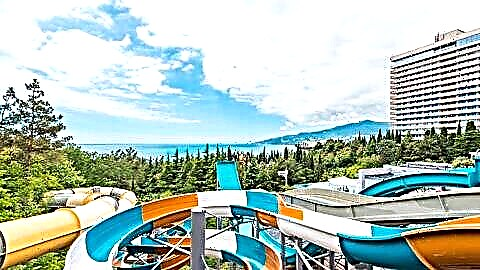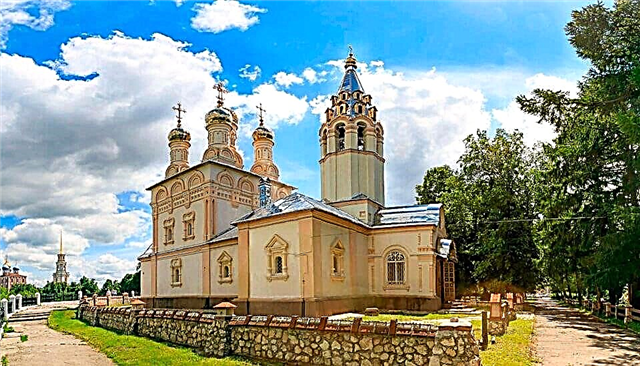Address: Moscow Kremlin, between Tsarskaya and Konstantino-Eleninskaya towers
Build date: 1495 year
Tower height: 38 m.
Coordinates: 55 ° 45'06.6 "N 37 ° 37'19.3" E
Content:
Short story
The Moscow Kremlin is a large architectural complex that includes many historical monuments, a wall and towers. There are many towers, more than 10, and one of them is called Nabatnaya. We will talk about it further.
Who built the Nabatnaya Tower is still unknown. But the approximate date of its construction is known - the end of the 15th century, 1495th year... A bell was installed on the tower, near which in the old days the sentinels were on duty, and the watch was carried out around the clock. However, the bell did not always ring. In 1771, Russia was going through the Plague Riot, the signal for the beginning of which was given precisely from the Nabatnaya Tower.

From left to right: Nabatnaya Tower, Tsarskaya Tower, Spasskaya Tower
Immediately after that, the Russian Empress Catherine II ordered to literally rip out the tongue from the bell. For 30 years after these events, the bell made no sound. By the way, that revolt did not last long and was successfully suppressed by Grigory Orlov, the count and at the same time the favorite of Empress Catherine II. Grigory Orlov became famous not only for his attractive appearance, remarkable physical strength, but also for the intelligence of a politician and military skill.
About the history of the Plague Riot
Moscow in the second half of the 18th century was "attacked" by the outbreak of the plague. In addition, there were several more reasons for the outbreak of the riot: hunger and bullying by the police of that time over the people reached the extreme extreme. But the main reason for the popular unrest was the following circumstance - the secret transfer of the icon, which was installed at the Barbarian Gate. Why was this done?

Archbishop Ambrose considered that if many people constantly gather around this icon in anticipation of salvation and healing from the plague, this will only contribute to an even greater spread of the disease. When the alarm bell rang again and the people (among whom were "boyar people, clerks, merchants and factory workers", as the chronicles of that time describe) discovered the absence of the icon, indignation reached its limit. The guards of the Moscow Kremlin were severely beaten by an angry mob. Archbishop Ambrose had to flee from the Chudov Monastery in Donskoy. Ambrose disappeared in time, since the Chudov Monastery was destroyed by the brutal people. But the archbishop did not manage to escape - he was found in the Donskoy monastery, destroyed the building and dealt with the archbishop.
The crowd raged more and more and in the end the following demand was put forward - to give up Yeropkin, who had settled in the Kremlin (at that time he served as a senator). Of course, the Kremlin authorities did not give Yeropkin away so easily, but tried to negotiate with the crowd. The chief commandant of the Kremlin was sent to the meeting as an ambassador. As soon as he left, stones immediately flew at him.

View of the tower from Vasilievsky Spusk square
From that moment, an order was given to start military operations against the rioters - they began to mercilessly shoot with cannon shot from cannons. It was a cruel sight! An eyewitness described that people were torn in half, tore off someone's head, someone's arms and legs. Moreover, one shot killed up to 10 people at a time. After the execution, the fugitives were pursued by special punitive detachments.
After this terrible day in the morning, when the bell began to ring, Red Square again gathered a crowd. They demanded to release the prisoners and cancel the plague quarantine. The authorities acted as brutally and decisively as before. The soldiers, who had been pulled together to guard the Kremlin, again opened fire on those gathered in Red Square, and the cavalry began to chop them to pieces with sabers. This was the last day of the uprising, which resulted in 4 people hanged, 72 were beaten with a whip and sent to the galleys.
Alarm tower in our time
In the 70s of the last century, the foundation of the Nabatnaya Tower gave a strong crack. From that time on, the tower began to lurch quite strongly.... Through the efforts of professional architects, this process was stopped, but so far no one has been leveling the tower. As a result of the tilt, the top of the tower moved away from the vertical axis by 1 meter.

Alarm tower against the background of the domes of the Ivan the Great Bell Tower
However, the slope of the Nabatnaya Tower made it special - after all, at present it is known not only as the Nabatnaya Tower, but also as the "Moscow Leaning Tower of Pisa".
And the alarm bell, the one from which the tongue was torn out, can be seen today in the lobby of the Armory.










